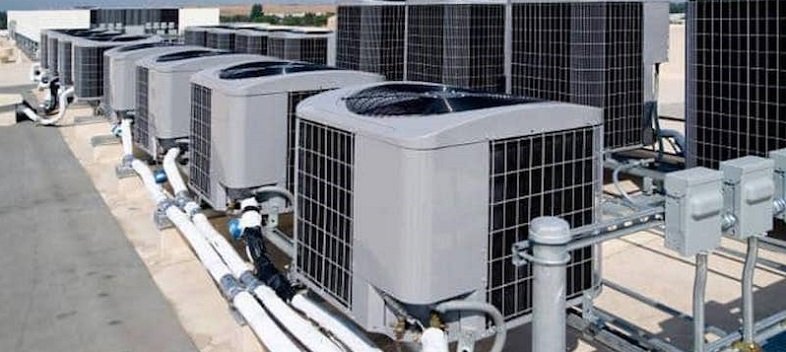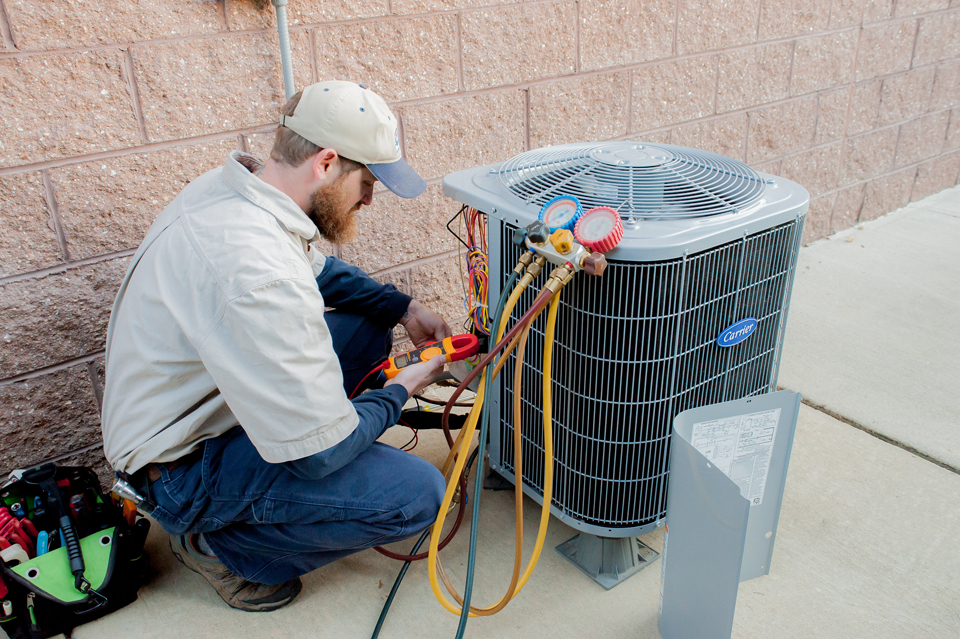Exactly How a Warm Pump and Furnace Interact to Enhance Your Home's Heating Performance
Comprehending how a heatpump and heating system interact is necessary for property owners seeking reliable heating remedies. Each system has its staminas, supplying a balanced strategy to home comfort. The heatpump masters moderate temperature levels, while the furnace supplies fast heat during severe cold. This synergy not only lowers power expenses but also boosts the life-span of both home appliances. What elements influence this collaboration, and exactly how can homeowners optimize their advantages?
Understanding Warmth Pumps: How They Work
Several people may be unknown with their internal operations, heat pumps play a vital duty in modern heating systems. These gadgets run by moving heat from one location to one more, using the concepts of thermodynamics. In cooler months, a heat pump extracts heat from the outside air, ground, or water, and transfers it inside your home to warm up the living room. Conversely, throughout warmer months, it can turn around the procedure, serving as an air conditioning system by expelling heat from inside to the outside.Heat pumps contain an evaporator, compressor, condenser, and development valve. The cooling agent within the system absorbs heat as it evaporates at reduced temperature levels and stress. The compressor after that increases the pressure and temperature of the cooling agent, permitting it to release heat as it condenses. This efficient process can considerably lower power intake contrasted to traditional heating approaches, making heatpump a lasting selection for environment control in homes.
The Function of Heaters in Home Home Heating
Furnaces play a vital duty in home heating by providing a reputable resource of heat throughout the chillier months. They operate by producing warm with combustion or electrical resistance, dispersing it throughout the home through ducts or radiant systems. The efficiency of a heating system is often determined by its Yearly Gas Application Performance (AFUE) rating, which shows how effectively the unit transforms gas into heat.Furnaces can utilize numerous energy resources, including gas, oil, gas, or electrical energy, allowing house owners to choose one of the most appropriate alternative for their needs. Unlike warmth pumps, which might battle in extreme chilly, heating systems preserve consistent efficiency, guaranteeing that interior temperatures stay comfy no matter exterior conditions. Furthermore, modern-day furnaces often come outfitted with advanced modern technology, such as variable-speed blowers and smart thermostats, boosting their effectiveness and responsiveness. This convenience makes furnaces a critical element in comprehensive home heating techniques.

Benefits of Using Both Equipments Together
Combining the toughness of both heaters and warm pumps can result in a more reliable and reliable home heating option. Using both systems allows homeowners to make the most of the warmth pump's power performance throughout milder temperatures while counting on the furnace for more extreme cold conditions. This dual method can considerably lower power prices, as warm pumps consume much less electrical energy than standard home heating approaches when temperature levels are moderate.Additionally, utilizing both systems with each other can enhance convenience levels in the home. Heatpump can offer regular, even home heating, while furnaces can rapidly elevate ambient temperatures when required. Additionally, the assimilation of both systems can prolong the life-span of equipment by minimizing wear and tear on each system, as they share the work. Ultimately, home owners can enjoy a balanced, cost-efficient heating service that readjusts seamlessly to varying weather condition problems, guaranteeing a warm and welcoming home throughout the winter season.
Just How Heat Pumps and Furnaces Enhance Each Various Other
They produce a corresponding home heating system that makes best use of efficiency and comfort when homeowners integrate heat pumps and furnaces. Heat pumps run by transferring heat from the outdoors air or ground, making them very efficient in modest environments. They excel throughout milder temperature levels, giving cost-effective heating. Conversely, furnaces generate warmth via burning or electrical resistance, providing strong, immediate heat during severe cool conditions.The mix of these two systems permits dynamic changes based upon temperature level changes. During warmer months or milder winter days, the warmth pump can take the lead, preserving power and lowering expenses. As temperatures drop, the heater can flawlessly engage, ensuring consistent warmth throughout the home. This harmony not only optimizes energy use yet likewise improves the lifespan of both systems, as each device runs within its excellent efficiency variety. Together, they create a balanced setting that adjusts to varying environment demands.
Maximizing Performance: Tips for Homeowners
Home owners can boost their heating efficiency with several useful approaches. Establishing a regular upkeep schedule, incorporating smart thermostat innovation, and executing reliable insulation and sealing options are essential actions. These steps not just improve comfort yet also lower energy expenses.
Normal Upkeep Schedule
To guarantee maximum home heating effectiveness, establishing a routine upkeep schedule is important for any type of home. Homeowners must focus on routine examinations of both heat pumps and heaters to determine peak efficiency. This consists of changing air filters every one to three months, as clogged up filters can considerably decrease efficiency. you could try here Furthermore, scheduling expert maintenance at the very least annually enables professionals to recognize and deal with potential problems prior to they intensify. Homeowners should also clean the warm pump's outside device to stop particles build-up that can hinder airflow. By adhering to a routine upkeep schedule, home owners not just improve their heater' efficiency yet also prolong their life-span, leading to higher comfort and reduced power costs throughout the cooler months.
Smart Thermostat Combination
Integrating a smart thermostat into a home furnace can significantly boost power effectiveness, particularly as it permits accurate control over temperature level settings. These gadgets can learn the homeowner's timetable and choices, immediately adjusting the temperature level to maximize convenience while lessening energy usage. They can lower heating during times when the home is empty, minimizing unneeded intake. Several wise thermostats ductless mini splits additionally offer real-time energy use information, allowing home owners to make educated choices about their heating behaviors. Additionally, remote access via mobile phone apps allows users to readjust setups from anywhere, making certain the home is cozy upon return. On the whole, clever thermostat integration not just improves comfort but significantly contributes to power financial savings and effectiveness.
Insulation and Sealing Solutions
Smart thermostats play a vital duty in energy performance, yet their effectiveness can be significantly enhanced by proper insulation and securing options. House owners need to focus on insulating floors, attic rooms, and walls to minimize warmth loss. Premium insulation products, such as spray foam or fiberglass, can significantly improve thermal resistance. Additionally, sealing voids around doors, windows, and air ducts prevents chilly air infiltration and heat retreat. Weatherstripping and caulking are efficient approaches for resolving these leakages - heat pump installation ooltewah tn. Normal assessments for air leaks, together with using blower door examinations, can aid identify problem areas. By purchasing insulation and securing, homeowners can maximize the efficiency of their heating unit, inevitably leading to decreased energy consumption and reduced utility costs
Usual Myths About Warmth Pumps and Furnaces
What misconceptions surround heat pumps and heating systems? Many individuals incorrectly believe that warm pumps are inefficient in cooler climates. In truth, modern-day warm pumps are designed to run effectively also in reduced temperature levels, providing trusted home heating throughout winter months. Another common myth is that heaters are constantly more reliable than heat pumps. This depends on the particular energy sources and efficiency ratings of the units in inquiry. Some may likewise think that making use of both systems at the same time is unneeded, but as a matter of fact, this mix can optimize home heating performance, especially during severe weather. Additionally, individuals usually think that heatpump require continuous maintenance, when actually, they have comparable maintenance requires to conventional heating unit. By disproving these misconceptions, homeowners can make even more enlightened choices regarding their home heating choices, eventually leading to enhanced comfort and power performance in their homes.
Maintenance Factors To Consider for Combined Systems

Regularly Asked Inquiries
Can Heat Pumps Work Successfully in Exceptionally Cold Climates?
Heatpump can have a hard time in very cool environments as a result of reduced efficiency and warm removal constraints. Developments in modern technology have actually led to designs created for much better performance in such conditions, improving their practicality in severe atmospheres.
How Much Time Do Heat Pumps and Furnaces Usually Last?
Heatpump generally last 15 to 20 years, while heaters have a life-span of 15 to thirty years. Regular upkeep can prolong their longevity, guaranteeing reliable procedure and decreasing the need for early substitutes.

What Is the Average Expense of Putting Up Both Systems?
The ordinary cost of setting up both a warmth pump and a furnace normally varies between $5,000 to $10,000 - heat pump installation ooltewah tn. Elements influencing this price include system size, setup intricacy, and local labor rates
Are There Tax Motivations for Using Energy-Efficient Heating Solutions?
Lots of home owners inquire regarding tax obligation motivations for energy-efficient furnace. Various federal and state programs typically supply credit reports or discounts, motivating the fostering of lasting modern technologies to lower energy consumption and advertise ecological duty.
Just how Do I Choose the Right Size Heatpump and Heater?
Picking the appropriate dimension heatpump and heating system includes calculating the home's square video, taking into consideration insulation top quality, and examining regional climate. Consulting a specialist can guarantee perfect system performance and energy efficiency based upon details demands. heat pump installation ooltewah tn. Recognizing just how a warm pump and heating system work with each other is essential for homeowners looking for reliable home heating options. In chillier months, a heat pump extracts warmth from the outdoors air, ground, or water, and transfers it inside your home to warm the living space. When home owners incorporate warmth pumps and heating systems, they create a complementary home heating system that makes best use of performance and convenience. Heat pumps run by moving heat from the outdoors air or ground, making them extremely efficient in modest environments. Heat pumps can battle in incredibly cold environments due to reduced performance and heat removal restrictions